GIS-Based Multi-Criteria Assessment of Managed Aquifer Recharge (MAR) Zones Using the Analytic Hierarchy Process (AHP) Method in Southern Kazakhstan
Abstract
1. Introduction
2. Materials and Methods
2.1. Study Area
2.2. Methodology of Research
- 1
- Very low suitability;
- 2
- Low suitability;
- 3
- Moderate suitability;
- 4
- High suitability;
- 5
- Very high suitability.
2.3. Uncertainty and Robustness Analysis (Monte Carlo and Fuzzy MCE)
3. Results
- ‑
- Quaternary alluvial–proluvial sequences in the Aspara and Merke fields (Kₓ: 10−3–10−2 m/s)
- ‑
- Neogene–Quaternary unconsolidated deposits of the Shu-Sarysu depression (specific yields: 25–85 L/s)
- ‑
- Fractured carbonate aquifers in Carboniferous karst systems (estimated recharge rates: 150–300 mm/year).
- ‑
- Pilot infiltration galleries in the Biylikol field (Qₜ: 82 L/s, sustainable yield);
- ‑
- Check dam systems along ephemeral channels in the Talas-Assa interfluve;
- ‑
- Injection wells targeting the Asparinskoe Quaternary aquifer (transmissivity: 500–800 m2/day).
4. Discussion
5. Conclusions
Author Contributions
Funding
Data Availability Statement
Conflicts of Interest
Appendix A
Appendix A.1. Results of Soil Sampling in the Zhambul Region
| Sampling No. | Date | Fraction Content, % | Soil Type | ||||||||||||
|---|---|---|---|---|---|---|---|---|---|---|---|---|---|---|---|
| Fraction Size, mm | |||||||||||||||
| >200 | 200–10 | 10–5 | 5–2 | 2–1 | 1–0.5 | 0.5–0.25 | 0.25–0.1 | 0.1–0.05 | 0.05–0.01 | 0.01–0.005 | 0.005–0.001 | <0.001 | |||
| 120-1 | 19/05/2024 | - | - | 0.25 | 0.75 | 0.67 | 0.79 | 3.74 | 6.88 | 13.75 | 33.71 | 15.24 | 16.36 | 7.86 | dusty heavy loam |
| 120-2 | 19/05/2024 | - | - | 0.29 | 0.95 | 0.79 | 0.88 | 3.23 | 6.37 | 19.60 | 33.08 | 12.28 | 15.05 | 7.47 | dusty heavy loam |
| 120-3 | 19/05/2024 | - | - | - | 0.98 | 0.85 | 0.59 | 4.12 | 6.68 | 18.07 | 31.97 | 15.02 | 13.91 | 7.81 | dusty heavy loam |
| 120-4 | 20/05/2024 | - | - | - | - | - | - | 1.70 | 4.20 | 14.64 | 41.96 | 13.36 | 6.67 | 17.46 | dusty heavy loam |
| 120-5 | 20/05/2024 | - | - | - | - | - | - | 1.50 | 3.80 | 15.64 | 43.02 | 12.86 | 12.30 | 10.86 | dusty heavy loam |
| 120-6 | 23/05/2024 | - | - | 1.00 | 1.37 | 0.62 | 0.10 | 4.46 | 6.60 | 20.41 | 25.22 | 11.32 | 15.20 | 13.70 | dusty heavy loam |
| 120-7 | 23/05/2024 | - | - | 0.82 | 1.45 | 0.56 | 0.19 | 3.69 | 7.48 | 21.48 | 27.47 | 7.90 | 15.87 | 13.08 | dusty heavy loam |
| 120-8 | 23/05/2024 | - | - | 0.62 | 1.87 | 0.71 | 0.29 | 2.71 | 6.68 | 21.82 | 29.39 | 9.36 | 9.65 | 16.90 | dusty heavy loam |
| 120-9 | 27/05/2024 | - | - | - | - | - | - | 1.00 | 3.00 | 15.28 | 29.40 | 13.93 | 16.60 | 20.79 | clay |
| 120-10 | 27/05/2024 | - | - | - | - | - | - | 0.70 | 2.80 | 14.84 | 30.33 | 12.77 | 18.10 | 20.46 | clay |
| 120-11 | 27/05/2024 | - | - | - | - | - | - | 1.00 | 2.70 | 12.21 | 33.70 | 9.60 | 20.33 | 20.46 | clay |
| 120-12 | 28/05/2024 | - | - | - | - | - | - | 1.50 | 3.00 | 18.27 | 39.92 | 9.66 | 15.33 | 12.29 | dusty heavy loam |
| 120-13 | 28/05/2024 | - | - | - | 0.04 | 0.14 | 0.70 | 6.89 | 6.59 | 13.05 | 46.59 | 8.32 | 11.55 | 6.15 | dusty heavy loam |
| 120-14 | 28/05/2024 | - | - | - | - | 0.01 | 0.20 | 0.80 | 6.10 | 15.44 | 47.09 | 8.30 | 12.63 | 9.42 | dusty heavy loam |
| 120-15 | 29/05/2024 | - | - | - | 0.37 | 0.33 | 0.20 | 2.48 | 2.98 | 20.10 | 29.72 | 9.93 | 20.19 | 13.69 | clay |
| 120-16 | 29/05/2024 | - | - | - | 0.34 | 0.31 | 0.10 | 2.58 | 2.88 | 20.28 | 30.43 | 10.66 | 18.12 | 14.30 | clay |
| 120-17 | 29/05/2024 | - | - | - | 0.36 | 0.37 | 0.10 | 2.98 | 2.68 | 19.99 | 30.47 | 10.65 | 18.40 | 13.99 | clay |
| 120-18 | 30/05/2024 | - | - | 0.51 | 0.12 | 0.09 | 0.10 | 0.79 | 3.08 | 15.18 | 40.28 | 12.27 | 12.55 | 15.03 | dusty heavy loam |
| 120-19 | 30/05/2024 | - | - | 0.48 | 0.11 | 0.10 | - | 0.89 | 3.18 | 20.60 | 38.07 | 10.82 | 14.37 | 11.38 | dusty heavy loam |
| 120-20 | 20/05/2024 | - | - | 0.37 | 0.10 | 0.10 | - | 0.70 | 2.98 | 25.39 | 34.10 | 12.30 | 12.46 | 11.49 | dusty heavy loam |
| 120-21 | 03/06/2024 | - | - | - | 0.01 | 0.21 | 0.20 | 1.40 | 3.79 | 17.10 | 36.58 | 13.30 | 14.20 | 13.20 | dusty heavy loam |
| 120-22 | 03/06/2024 | - | - | - | 0.04 | 0.23 | 0.30 | 1.30 | 3.99 | 18.29 | 35.44 | 10.60 | 16.62 | 13.19 | dusty heavy loam |
| 120-23 | 06/06/2024 | - | - | - | - | 0.06 | - | 0.10 | 4.60 | 14.50 | 40.64 | 11.66 | 17.66 | 10.78 | dusty heavy loam |
| 120-24 | 06/06/2024 | - | - | - | - | 0.07 | - | 0.20 | 4.50 | 14.96 | 40.44 | 11.39 | 17.65 | 10.78 | dusty heavy loam |
| 120-25 | 06/06/2024 | - | - | - | - | 0.06 | - | - | 3.60 | 15.60 | 39.97 | 13.36 | 16.62 | 10.78 | dusty heavy loam |
| 120-26 | 12/06/2024 | - | - | - | - | 0.08 | - | - | 2.40 | 17.23 | 40.10 | 12.72 | 17.69 | 9.78 | dusty heavy loam |
| 120-27 | 12/06/2024 | - | - | - | - | 0.09 | - | - | 2.10 | 17.09 | 40.96 | 12.32 | 16.98 | 10.45 | dusty heavy loam |
| 120-28 | 12/06/2024 | - | - | - | 0.16 | 0.05 | 0.70 | 1.10 | 5.29 | 18.14 | 37.62 | 10.91 | 16.66 | 9.37 | dusty heavy loam |
| Sampling No. | Sampling Location | Depth, m | Date | Humus | Petroleum Hydrocarbons |
|---|---|---|---|---|---|
| % | mg/kg | ||||
| 120-1 | Kordai district (Georgievskoe–Talapty wellfield) | 0.5 | 19/05/2024 | 0.0329 | 0.0077 |
| 1.0 | 19/05/2024 | 0.0348 | 0.0075 | ||
| 0.5 and 1.0 | 19/05/2024 | 0.0336 | 0.0076 | ||
| 120-2 | Kordai district (Georgievskoe–Talapty wellfield) | 0.5 | 19/05/2024 | 0.0421 | 0.0081 |
| 1.0 | 19/05/2024 | 0.0385 | 0.0078 | ||
| 0.5 and 1.0 | 19/05/2024 | 0.0415 | 0.0078 | ||
| 120-3 | Kordai district (Georgievskoe–Talapty wellfield) | 0.5 | 19/05/2024 | 0.0271 | 0.0076 |
| 1.0 | 19/05/2024 | 0.0289 | 0.0072 | ||
| 0.5 and 1.0 | 19/05/2024 | 0.0278 | 0.0075 | ||
| 120-4 | Akermensky District (Asparinskoe Wellfield) | 0.5 | 20/05/2024 | 0.0295 | 0.005 |
| 1.0 | 20/05/2024 | 0.0219 | 0.0043 | ||
| 0.5 and 1.0 | 20/05/2024 | 0.0253 | 0.0046 | ||
| 120-5 | Akermensky District (Asparinskoe Wellfield) | 0.5 | 20/05/2024 | 0.0325 | 0.0053 |
| 1.0 | 20/05/2024 | 0.0264 | 0.0044 | ||
| 0.5 and 1.0 | 20/05/2024 | 0.0286 | 0.0049 | ||
| 120-6 | Andas Batyr District (Merke Wellfield) | 0.5 | 23/05/2024 | 0.0405 | 0.0041 |
| 1.0 | 23/05/2024 | 0.0465 | 0.0038 | ||
| 0.5 and 1.0 | 23/05/2024 | 0.0437 | 0.0038 | ||
| 120-7 | Andas Batyr District (Merke Wellfield) | 0.5 | 23/05/2024 | 0.0463 | 0.0043 |
| 1.0 | 23/05/2024 | 0.0433 | 0.0038 | ||
| 0.5 and 1.0 | 23/05/2024 | 0.0466 | 0.0041 | ||
| 120-8 | Andas Batyr District (Merke Wellfield) | 0.5 | 23/05/2024 | 0.0401 | 0.0039 |
| 1.0 | 23/05/2024 | 0.0404 | 0.0033 | ||
| 0.5 and 1.0 | 23/05/2024 | 0.0403 | 0.0034 | ||
| 120-9 | Akbulaksky District (Lugovskoye wellfield) | 0.5 | 27/05/2024 | 0.0272 | 0.0041 |
| 1.0 | 27/05/2024 | 0.0284 | 0.0039 | ||
| 0.5 and 1.0 | 27/05/2024 | 0.027 | 0.0041 | ||
| 120-10 | Akbulaksky District (Lugovskoye wellfield)) | 0.5 | 27/05/2024 | 0.0339 | 0.0041 |
| 1.0 | 27/05/2024 | 0.0396 | 0.0039 | ||
| 0.5 and 1.0 | 27/05/2024 | 0.0383 | 0.004 | ||
| 120-11 | Akbulaksky District (Lugovskoye wellfield) | 0.5 | 27/05/2024 | 0.0301 | 0.0044 |
| 1.0 | 27/05/2024 | 0.0312 | 0.0041 | ||
| 0.5 and 1.0 | 27/05/2024 | 0.0309 | 0.0042 | ||
| 120-12 | Akyrtobinsky District (Podgornenskoe Wellfield) | 0.5 | 28/05/2024 | 0.0172 | 0.0023 |
| 1.0 | 28/05/2024 | 0.0209 | 0.0018 | ||
| 0.5 and 1.0 | 28/05/2024 | 0.0177 | 0.0022 | ||
| 120-13 | Abai District (Podgornenskoe Wellfield)) | 0.5 | 28/05/2024 | 0.0255 | 0.0016 |
| 1.0 | 28/05/2024 | 0.0198 | 0.0012 | ||
| 0.5 and 1.0 | 28/05/2024 | 0.022 | 0.0014 | ||
| 120-14 | Zhanaturmysky District (Podgornenskoe Wellfield) | 0.5 | 28/05/2024 | 0.0452 | 0.0026 |
| 1.0 | 28/05/2024 | 0.0346 | 0.0021 | ||
| 0.5 and 1.0 | 28/05/2024 | 0.0508 | 0.0022 | ||
| 120-15 | Mynbulaksky District (Dzhvalinskoe Wellfield) | 0.5 | 29/05/2024 | 0.0479 | 0.0035 |
| 1.0 | 29/05/2024 | 0.0503 | 0.0032 | ||
| 0.5 and 1.0 | 29/05/2024 | 0.0505 | 0.0033 | ||
| 120-16 | Mynbulaksky District (Dzhvalinskoe Wellfield) | 0.5 | 29/05/2024 | 0.056 | 0.0043 |
| 1.0 | 29/05/2024 | 0.0535 | 0.004 | ||
| 0.5 and 1.0 | 29/05/2024 | 0.0588 | 0.0042 | ||
| 120-17 | Mynbulaksky District (Dzhvalinskoe Wellfield) | 0.5 | 29/05/2024 | 0.046 | 0.0043 |
| 1.0 | 29/05/2024 | 0.0477 | 0.0035 | ||
| 0.5 and 1.0 | 29/05/2024 | 0.0441 | 0.0042 | ||
| 120-18 | Shakpaksky District (Shakpakata Wellfield) | 0.5 | 30/05/2024 | 0.0228 | 0.003 |
| 1.0 | 30/05/2024 | 0.029 | 0.0028 | ||
| 0.5 and 1.0 | 30/05/2024 | 0.028 | 0.0029 | ||
| 120-19 | Shakpaksky District (Shakpakata Wellfield) | 0.5 | 30/05/2024 | 0.0277 | 0.0033 |
| 1.0 | 30/05/2024 | 0.0259 | 0.0029 | ||
| 0.5 and 1.0 | 30/05/2024 | 0.0273 | 0.003 | ||
| 120-20 | Shakpaksky District (Shakpakata Wellfield) | 0.5 | 30/05/2024 | 0.0275 | 0.0032 |
| 1.0 | 30/05/2024 | 0.0261 | 0.0029 | ||
| 0.5 and 1.0 | 30/05/2024 | 0.0262 | 0.0029 | ||
| 120-21 | Karakemersky District (Biilikol Wellfield) | 0.5 | 03/06/2024 | 0.0278 | 0.0032 |
| 1.0 | 03/06/2024 | 0.0227 | 0.0027 | ||
| 0.5 and 1.0 | 03/06/2024 | 0.0265 | 0.0026 | ||
| 120-22 | Karakemersky District (Biilikol Wellfield) | 0.5 | 03/06/2024 | 0.0238 | 0.0039 |
| 1.0 | 03/06/2024 | 0.0214 | 0.0029 | ||
| 0.5 and 1.0 | 03/06/2024 | 0.0233 | 0.0036 | ||
| 120-23 | Baykadamsky District (Akzhar Wellfield) | 0.5 | 06/06/2024 | 0.0203 | 0.0032 |
| 1.0 | 06/06/2024 | 0.0233 | 0.003 | ||
| 0.5 and 1.0 | 06/06/2024 | 0.0216 | 0.0031 | ||
| 120-24 | Baykadamsky District (Akzhar Wellfield) | 0.5 | 06/06/2024 | 0.0252 | 0.0038 |
| 1.0 | 06/06/2024 | 0.0219 | 0.0036 | ||
| 0.5 and 1.0 | 06/06/2024 | 0.0254 | 0.0038 | ||
| 120-25 | Baykadamsky District (Akzhar Wellfield) | 0.5 | 06/06/2024 | 0.022 | 0.0039 |
| 1.0 | 06/06/2024 | 0.026 | 0.0036 | ||
| 0.5 and 1.0 | 06/06/2024 | 0.0234 | 0.0036 | ||
| 120-26 | Madimar Yntymaksky District (Talas-Assa Wellfield) | 0.5 | 12/06/2024 | 0.0309 | 0.0054 |
| 1.0 | 12/06/2024 | 0.0318 | 0.0052 | ||
| 0.5 and 1.0 | 12/06/2024 | 0.0309 | 0.0054 | ||
| 120-27 | Madimar Yntymaksky District (Talas-Assa Wellfield) | 0.5 | 12/06/2024 | 0.0305 | 0.0054 |
| 1.0 | 12/06/2024 | 0.0327 | 0.0048 | ||
| 0.5 and 1.0 | 12/06/2024 | 0.0311 | 0.0052 | ||
| 120-28 | Zhalgyztobinsky District (Talas-Assa Wellfield) | 0.5 | 12/06/2024 | 0.1167 | 0.0032 |
| 1.0 | 12/06/2024 | 0.1351 | 0.0029 | ||
| 0.5 and 1.0 | 12/06/2024 | 0.1156 | 0.0031 |
Appendix A.2. Results of Groundwater Sampling in the Zhambul Region
| Sampling Location | Ca (meq%) | Mg (meq%) | Na + K (meq%) | Cl (meq%) | CO3 + HCO3 (meq%) | SO4 (meq%) | TDS (mg/L) | pH |
|---|---|---|---|---|---|---|---|---|
| well No.1, Aspara wellfield | 30.81 | 24.00 | 45.18 | 8.74 | 82.07 | 9.20 | 80 | 7.8 |
| well No.2, Aspara wellfield | 30.13 | 24.69 | 45.18 | 9.23 | 76.25 | 14.52 | 94.5 | 7.88 |
| well No.3, Aspara wellfield | 22.80 | 17.13 | 60.07 | 14.13 | 67.22 | 18.65 | 97 | 8.17 |
| well No.4, Merke wellfield | 66.52 | 18.17 | 15.31 | 8.54 | 84.96 | 6.50 | 85 | 8.06 |
| well No.5, Merke wellfield | 61.69 | 16.85 | 21.45 | 6.55 | 84.55 | 8.90 | 88.3 | 7.98 |
| well No.6, Merke wellfield | 53.65 | 11.31 | 35.04 | 8.39 | 79.79 | 11.82 | 93.5 | 7.91 |
| well No.7, Merke wellfield | 51.58 | 25.83 | 22.59 | 8.03 | 84.24 | 7.73 | 87 | 7.87 |
| well No.8, Merke wellfield | 50.22 | 22.64 | 27.14 | 6.79 | 81.44 | 11.78 | 102 | 7.79 |
| well No.9, Lygovskoye wellfield | 39.98 | 25.17 | 34.85 | 19.07 | 46.48 | 34.45 | 234 | 7.48 |
| well No.10, Merke wellfield | 26.00 | 37.75 | 36.25 | 30.80 | 19.42 | 49.79 | 234 | 7.48 |
| well No.11, Merke wellfield | 24.92 | 32.76 | 42.33 | 19.21 | 52.19 | 28.60 | 183 | 8.16 |
| well No.12, Zhualy wellfield | 45.98 | 41.45 | 12.56 | 4.50 | 82.95 | 12.54 | 103 | 7.23 |
| well No.13, Zhualy wellfield | 45.11 | 42.83 | 12.06 | 4.84 | 81.95 | 13.22 | 103 | 7.99 |
| well No.14, Zhualy wellfield | 46.20 | 41.40 | 12.40 | 5.20 | 81.63 | 13.17 | 102 | 8.03 |
| well No.15, Shakpakty wellfield | 53.63 | 36.23 | 10.14 | 4.45 | 90.04 | 5.51 | 186 | 7.97 |
| well No.16, Shakpakty wellfield | 53.31 | 36.08 | 10.61 | 5.89 | 88.77 | 5.34 | 160 | 7.48 |
| well No.17, Shakpakty wellfield | 54.01 | 34.68 | 11.31 | 6.04 | 88.24 | 5.72 | 173 | 7.97 |
| well No.18, Bijlikol wellfield | 33.58 | 20.51 | 45.92 | 9.83 | 44.31 | 45.86 | 331 | 7.96 |
| well No.19, Akzhar wellfield | 38.60 | 28.99 | 32.41 | 7.14 | 68.36 | 24.50 | 262 | 8 |
| well No.20, Akzhar wellfield | 35.31 | 33.35 | 31.34 | 7.01 | 68.18 | 24.81 | 253 | 8.01 |
| well No.21, Akzhar wellfield | 32.24 | 26.59 | 41.16 | 9.80 | 67.54 | 22.66 | 269 | 8.03 |
| well No.22, Akzhar wellfield | 29.40 | 25.76 | 44.84 | 9.36 | 63.65 | 26.98 | 299 | 8.08 |
| well No.23, Talas-Assa wellfield | 45.90 | 36.89 | 17.21 | 12.43 | 58.81 | 28.77 | 470 | 7.58 |
| well No.24, Talas-Assa wellfield | 50.26 | 35.37 | 14.37 | 8.97 | 64.69 | 26.35 | 353 | 7.58 |
| well No.25, Talas-Assa wellfield | 51.75 | 34.79 | 13.46 | 9.09 | 66.15 | 24.76 | 338 | 7.67 |
References
- Adenova, D.; Tazhiyev, S.; Sagin, J.; Absametov, M.; Murtazin, Y.; Trushel, L.; Miroshnichenko, O.; Zaryab, A. Groundwater quality and potential health risk in Zhambyl Regio, Kazakhstan. Water 2023, 15, 482. [Google Scholar] [CrossRef]
- Absametov, M.K.; Murtazin, E.Z.; Ospanov, K.T.; Smolyar, V.A. Groundwater Resource Potential of Kazakhstan as a Source of Sustainable Drinking Water Supply; Smart University Press: Almaty, Republic of Kazakhstan, 2023. [Google Scholar]
- Absametov, M.K.; Ayazbayev, R.; Kuldeev, E.I.; Murtazin, E.Z.; Smolyar, V.A. Atlas of Hydrogeological Maps of the Republic of Kazakhstan; Institute of Hydrogeology and Geoecology Named After Ahmedsafin: Almaty, Republic of Kazakhstan, 2023. [Google Scholar]
- Mouhoumed, R.M.; Ekmekcioğlu, Ö.; Başakın, E.E.; Özger, M. Integrated fuzzy AHP-TOPSIS model for assessing managed aquifer recharge potential in a hot dry region: A case study of Djibouti at a country scale. Water 2023, 15, 2534. [Google Scholar] [CrossRef]
- Seif, A.K.; Masria, A.; Ghareeb, M.; Saleh, A.A.; Soliman, K.; Ammar, A.I. Identifying managed aquifer recharge and rainwater harvesting sites and structures for storing non-conventional water using GIS-based multi-criteria decision analysis approach. Appl. Water Sci. 2024, 14, 181. [Google Scholar] [CrossRef]
- Canora, F.; Muzzillo, R.; Sdao, F. Groundwater vulnerability assessment in the Metaponto coastal plain (Basilicata, Italy). Water 2022, 14, 1851. [Google Scholar] [CrossRef]
- Speijer, L.; Six, S.; van der Grift, B.; Cirkel, D.G.; Verreydt, G.; Dams, J.; Huysmans, M. Enhancing groundwater recharge in drinking water protection zones in Flanders (Belgium): A novel approach to assess stormwater managed aquifer recharge potential. J. Hydrol. Reg. Stud. 2024, 50, 101747. [Google Scholar] [CrossRef]
- Maréchal, J.-C.; Bouzit, M.; Rinaudo, J.-D.; Moiroux, F.; Desprats, J.-F.; Caballero, Y. Mapping economic feasibility of managed aquifer recharge. Water 2020, 12, 680. [Google Scholar] [CrossRef]
- Ebrahim, G.Y.; Stefan, C.; Sallwey, J.; Lautze, J. Mapping the potential of managed aquifer recharge in Africa: GIS-based multi-criteria decision analysis approach. Groundw. Sustain. Dev. 2024, 14, 101374. [Google Scholar] [CrossRef]
- Hani, H.M.; El Din, M.M.N.; Khalifa, A.; Elalfy, E. Development of suitability map for managed aquifer recharge: Case study, West Delta, Egypt. Aqua 2023, 72, 868–884. [Google Scholar] [CrossRef]
- Afzal, M.; Liu, T.; Butt, A.Q.; Nadeem, A.A.; Ali, S.; Pan, X. Geospatial assessment of managed aquifer recharge potential sites in Punjab, Pakistan. Remote Sens. 2023, 15, 3988. [Google Scholar] [CrossRef]
- Farswan, S.; Vishwakarma, C.A.; Mina, U.; Kumar, V.; Mukherjee, S. Assessment of rainwater harvesting sites in a part of North-West Delhi, India using geomatic tools. Environ. Earth Sci. 2019, 78, 329. [Google Scholar] [CrossRef]
- Alelaimat, A.; Yusoff, I.; Nizar, M.K.; Ng, T.F.; Majali, Y.A. Groundwater management in the face of climate change: Enhancing groundwater storage in the alluvium aquifer of Wadi Arabah, Jordan, through GIS-based managed aquifer recharge and groundwater MODFLOW. Water Supply 2023, 23, 5136–5153. [Google Scholar] [CrossRef]
- Sallwey, J.; Ongdas, N.; Al-Hosban, M.; Stefan, C. Mapping the potential for managed aquifer recharge in Kazakhstan. Cent. Asian J. Water Res. 2024, 10, 95–116. [Google Scholar] [CrossRef]
- Russo, T.A.; Fisher, A.T.; Lockwood, B.S. Assessment of managed aquifer recharge site suitability using a GIS and modeling. Groundwater 2015, 53, 389–400. [Google Scholar] [CrossRef] [PubMed]
- Yeh, H.-F.; Cheng, Y.-S.; Lin, H.-I.; Lee, C.-H. Mapping groundwater recharge potential zone using a GIS approach in Hualian River, Taiwan. Sustain. Environ. Res. 2016, 26, 33–43. [Google Scholar] [CrossRef]
- Sallwey, J.; Bonilla Valverde, J.P.; Vásquez López, F.; Junghanns, R.; Stefan, C. Suitability maps for managed aquifer recharge: A review of multi-criteria decision analysis studies. Environ. Rev. 2019, 27, 138–150. [Google Scholar] [CrossRef]
- Mantel, S.K.; Rivers-Moore, N.; Ramulifho, P. Small dams need consideration in riverscape conservation assessments. Aquat. Conserv. 2017, 27, 748–754. [Google Scholar] [CrossRef]
- Ashraf, M.; Kahlown, M.A.; Ashfaq, A. Impact of small dams on agriculture and groundwater development: A case study from Pakistan. Agric. Water Manag. 2007, 92, 90–98. [Google Scholar] [CrossRef]
- Escalante, E.F.; Casas, J.D.H.; Per, C.M.d.G.; Vera, M.D.M.; Valverde, C.M. Unintentional recharge of aquifers from small dams and dykes in Spain: A GIS-based approach to determine a fractional volume. Earth 2023, 4, 584–605. [Google Scholar] [CrossRef]
- Kazakis, N.; Karakatsanis, D.; Ntona, M.M.; Polydoropoulos, K.; Zavridou, E.; Voudouri, K.A.; Busico, G.; Kalaitzidou, K.; Patsialis, T.; Perdikaki, M.; et al. Groundwater depletion. Are environmentally friendly energy recharge dams a solution? Water 2024, 16, 1541. [Google Scholar] [CrossRef]
- Papadopoulos, C.; Spiliotis, M.; Pliakas, F.; Gkiougkis, I.; Kazakis, N.; Papadopoulos, B. Hybrid Fuzzy Multi-Criteria Analysis for Selecting Discrete Preferable Groundwater Recharge Sites. Water 2022, 14, 107. [Google Scholar] [CrossRef]
- Abdulrazzaq, Z.T.; Agbasi, O.E.; Aziz, N.A.; Hamid, O.S.; Abdulrazzaq, A.Z. Identification of potential groundwater locations using geophysical data and fuzzy gamma operator model in Imo, Southeastern Nigeria. Appl. Water Sci. 2020, 10, 188. [Google Scholar] [CrossRef]
- Adam, A.B.; Appiah-Adjei, E.K.; Adjei, K.A.; Alhassan, A.; Anim, A.O.; Agodzo, S.K.; Miezah, K. Managed aquifer recharge site suitability analysis in the Nabogo Basin of Ghana using GIS and Monte Carlo simulation-aided analytic hierarchy process. Arab. J. Geosci. 2024, 17, 76. [Google Scholar] [CrossRef]
- Ligmann-Zielinska, A.; Jankowski, P. Spatially-Explicit Integrated Uncertainty and Sensitivity Analysis of Criteria Weights in Multicriteria Land Suitability Evaluation. Environ. Model. Softw. 2014, 57, 235–247. [Google Scholar] [CrossRef]
- UNESCO. The United Nations World Water Development Report 2025: Mountains and Glaciers—Water Towers; United Nations Educational, Scientific and Cultural Organization: Paris, France, 2025; Available online: https://www.unwater.org/publications/un-world-water-development-report-2025 (accessed on 3 September 2025).
- ISO/IEC 17025:2017; General Requirements for the Competence of Testing and Calibration Laboratories. International Organization for Standardization. International Electrotechnical Commission: Geneva, Switzerland, 2017. Available online: https://www.iasonline.org/services/testing-laboratories/ (accessed on 14 September 2025).
- Messerschmid, C.; Aliewi, A. Spatial distribution of groundwater recharge based on regionalized soil moisture models in Wadi Natuf karst aquifers, Palestine. Hydrol. Earth Syst. Sci. 2022, 26, 1043–1061. [Google Scholar] [CrossRef]
- Scanlon, B.R.; Keese, K.E.; Flint, A.L.; Flint, L.E.; Gaye, C.B.; Edmunds, W.M.; Simmers, I. Global synthesis of groundwater recharge in semiarid and arid regions. Hydrol. Process. 2006, 20, 3335–3370. [Google Scholar] [CrossRef]
- Hassan, W.H.; Ghanim, A.A.J.; Mahdi, K.; Adham, A.; Mahdi, F.A.; Nile, B.K.; Riksen, M.; Ritsema, C. Effect of artificial (pond) recharge on the salinity and groundwater level in Al-Dibdibba aquifer in Iraq using treated wastewater. Water 2023, 15, 695. [Google Scholar] [CrossRef]
- Diriba, D.; Karuppannan, S.; Takele, T.; Husein, M. Delineation of groundwater potential zonation using geoinformatics and AHP techniques with remote sensing data. Heliyon 2024, 10, e25532. [Google Scholar] [CrossRef]
- Thiyagarajan, S.; Subbarayan, S. Groundwater potential zone mapping using analytical hierarchy process (AHP) and GIS for Kancheepuram District, Tamil Nadu, India. Model. Earth Syst. Environ. 2020, 6, 1105–1122. [Google Scholar] [CrossRef]
- Kassa, A.; Roba, N.; Habtamu, A.; Girma, B.; Adane, Z. Identifying groundwater recharge potential zone using analytical hierarchy process (AHP) in the semi-arid Shinile watershed, Eastern Ethiopia. Water Pract. Technol. 2023, 18, 2841–2858. [Google Scholar] [CrossRef]
- Maliva, R. Managed aquifer recharge: State-of-the-art and opportunities. Water Supply 2015, 15, 578–588. [Google Scholar] [CrossRef]
- Zhang, H.; Xu, Y.; Kanyerere, T. Site assessment for MAR through GIS and modeling in West Coast, South Africa. Water 2019, 11, 1646. [Google Scholar] [CrossRef]
- Parizi, E.; Hosseini, S.M.; Ataie-Ashtiani, B.; Simmons, C.T. Normalized difference vegetation index as the dominant predicting factor of groundwater recharge in phreatic aquifers: Case studies across Iran. Sci. Rep. 2020, 10, 17473. [Google Scholar] [CrossRef] [PubMed]
- El-Bagoury, H.; Darwish, M.; Hassan, S.; Oh, S.; Attia, K.; Megahed, H. Potentiality Delineation of Groundwater Recharge in Arid Regions Using Multi-Criteria Analysis. Water 2025, 17, 766. [Google Scholar] [CrossRef]
- Kumar, V.; Chaplot, B.; Omar, P.J.; Mishra, S.; Azamathulla, H.M. Experimental Study on Infiltration Pattern: Opportunities for Sustainable Management in the Northern Region of India. Water Sci. Technol. 2021, 84, 2675–2685. [Google Scholar] [CrossRef]
- Ibrakhimov, M.; Khamzina, A.; Forkutsa, I.; Lamers, J.P.A.; Tischbein, B.; Vlek, P.L.G.; Martius, C. Groundwater table and salinity: Spatial and temporal distribution and influence on soil salinization in Khorezm region (Uzbekistan, Aral Sea Basin). Irrig. Drain. Syst. 2007, 21, 219–236. [Google Scholar] [CrossRef]
- Karimov, A.K.; Amirova, I.; Karimov, A.A.; Tohirov, A.; Abdurakhmanov, B. Water, Energy and Carbon Tradeoffs of Groundwater Irrigation-Based Food Production: Case Studies from Fergana Valley, Central Asia. Sustainability 2022, 14, 1451. [Google Scholar] [CrossRef]

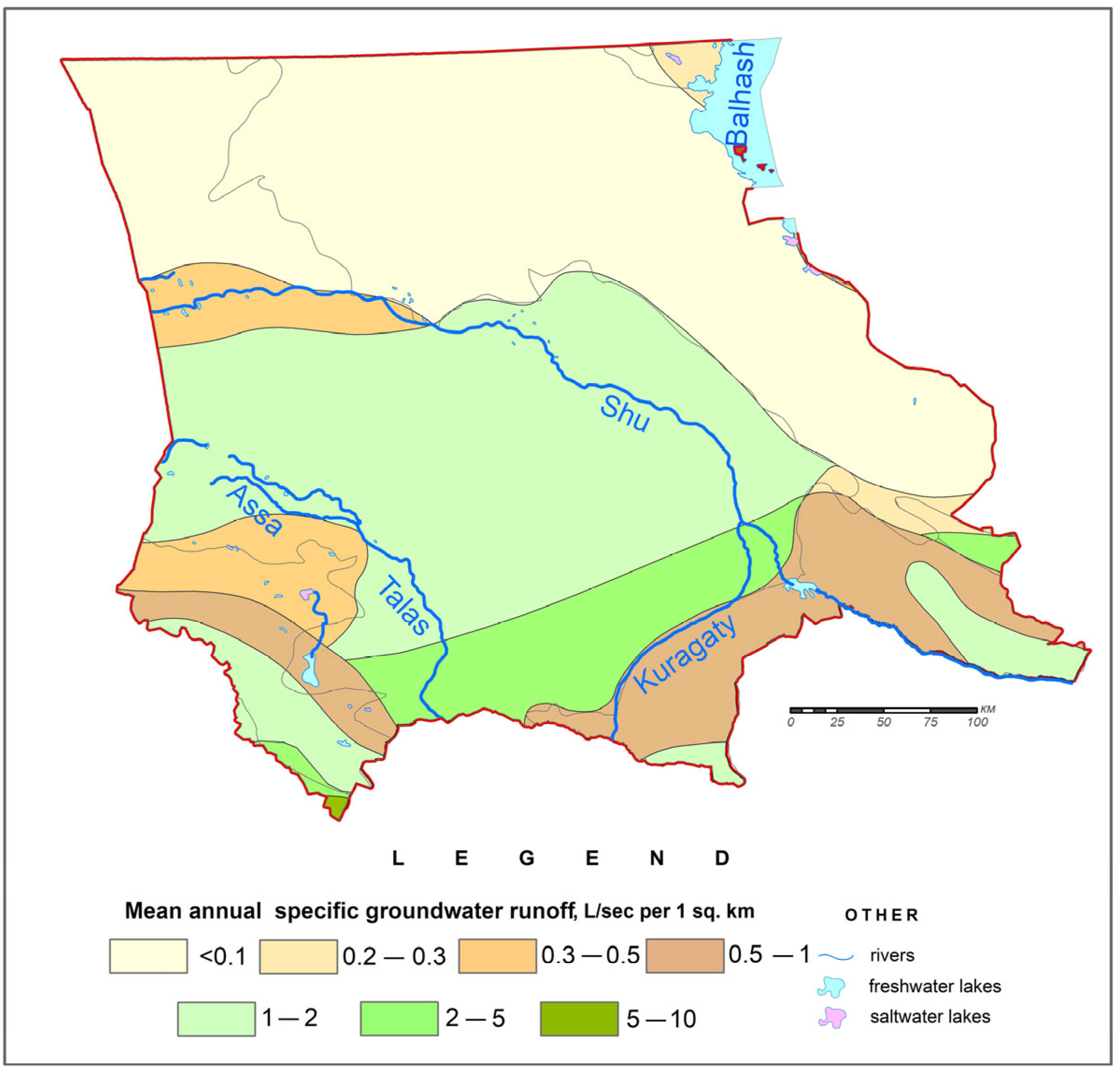

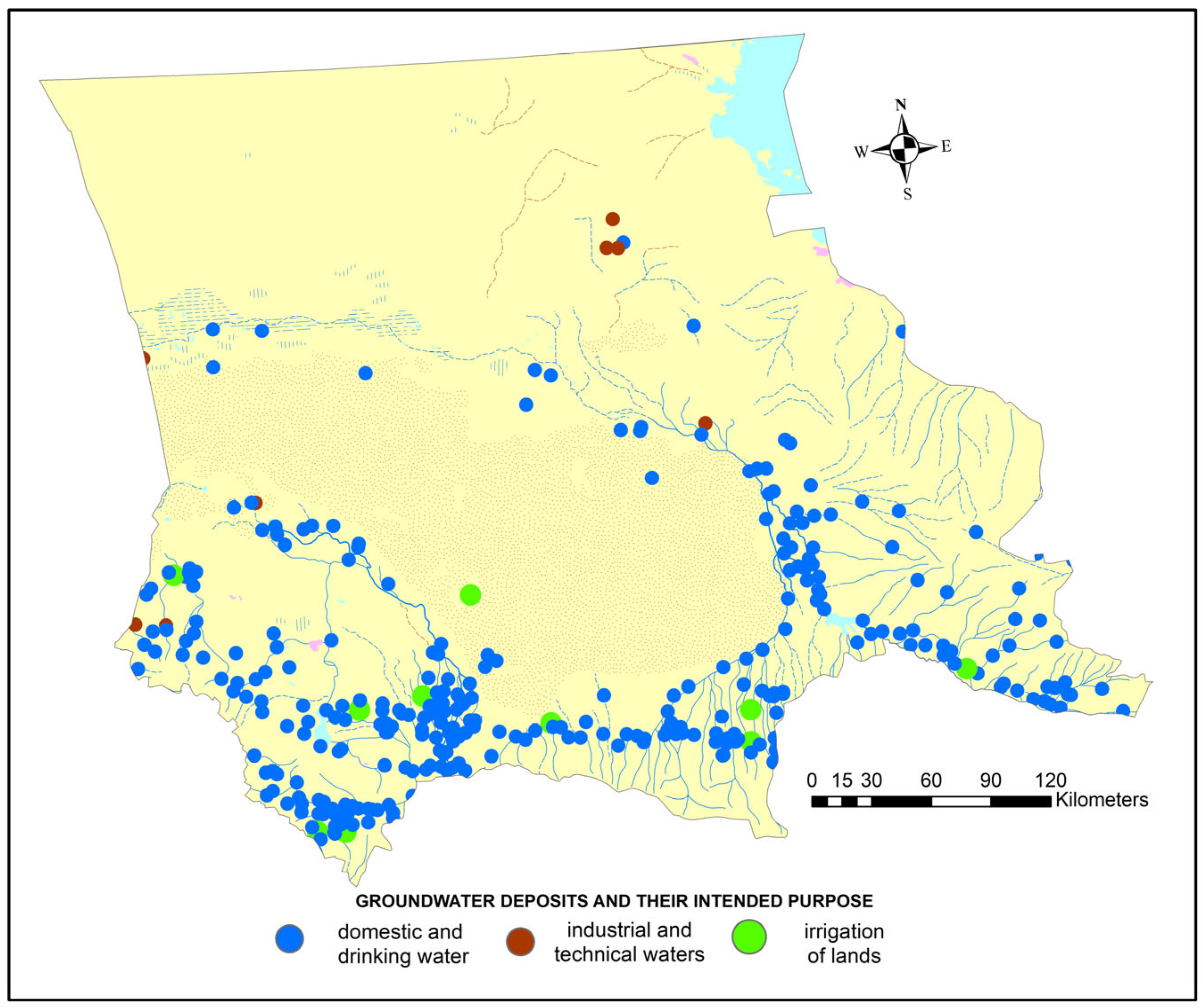
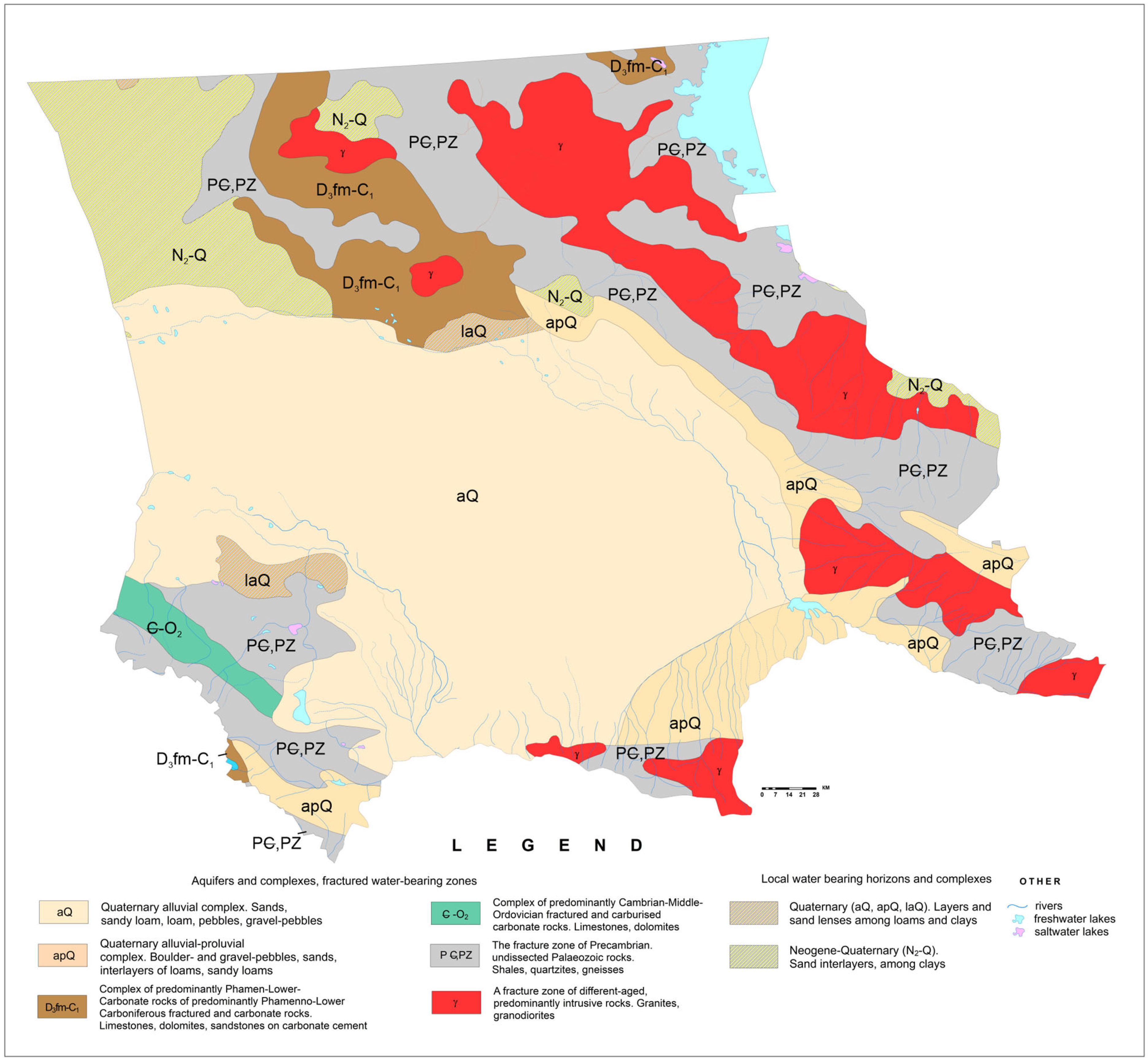
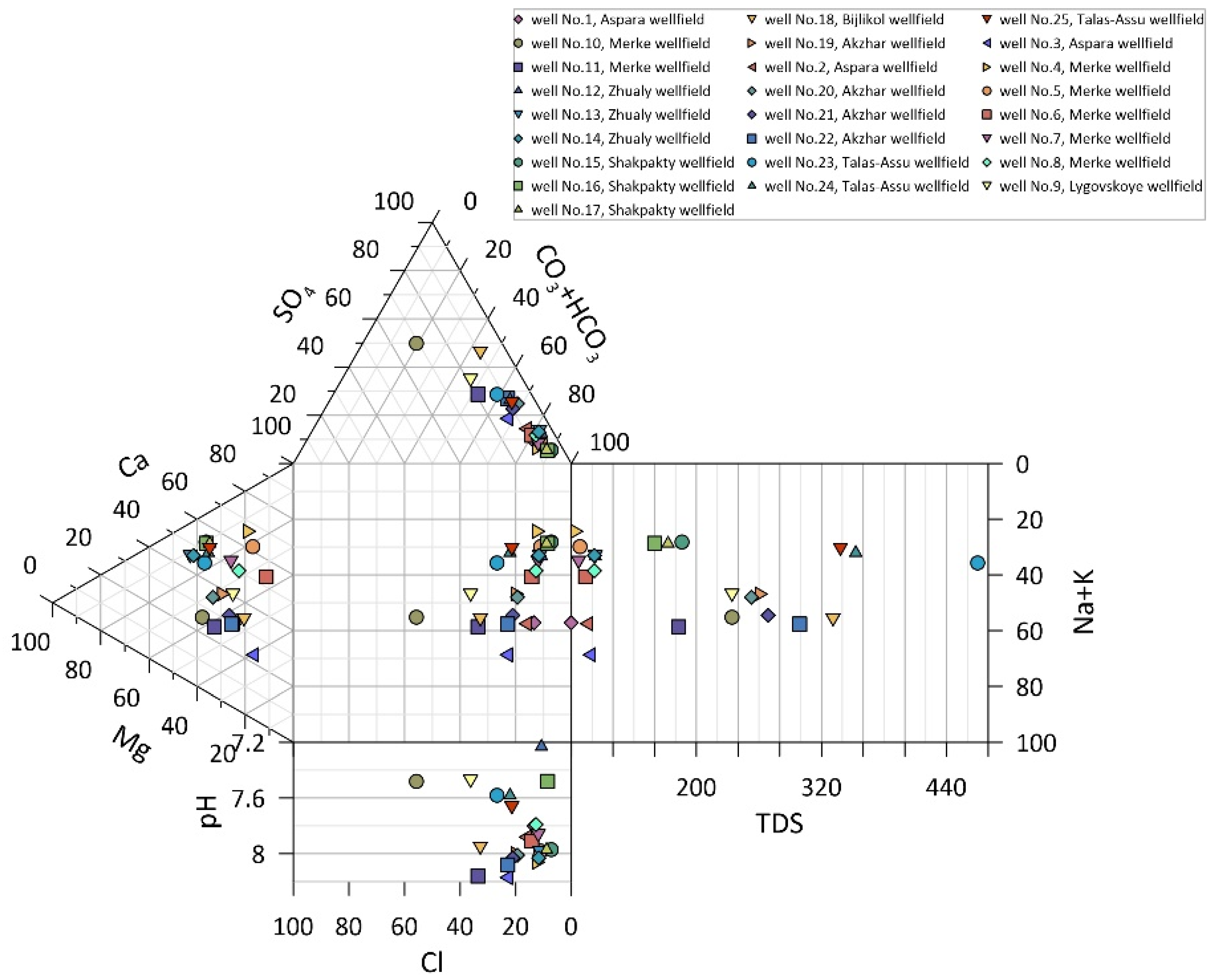
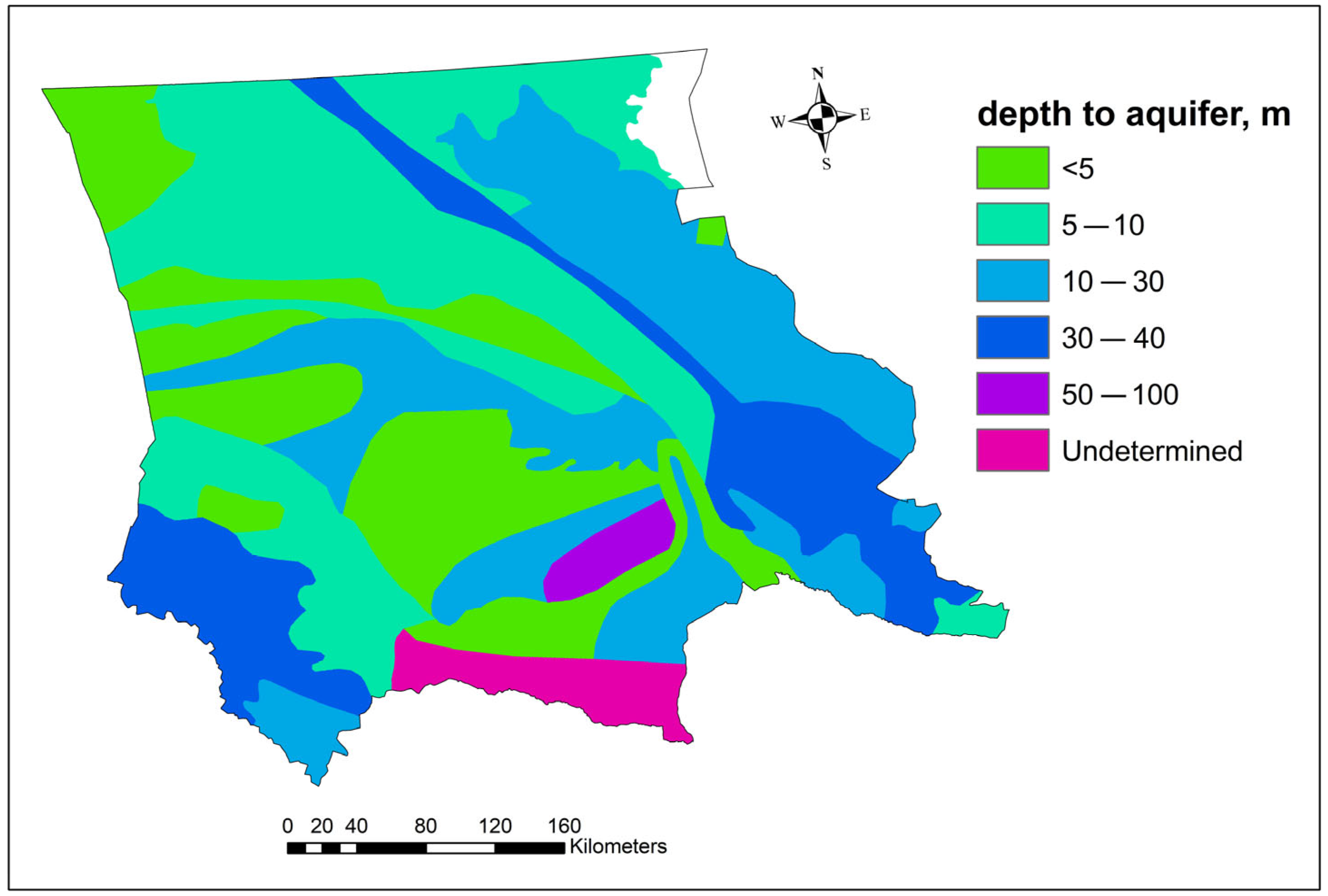
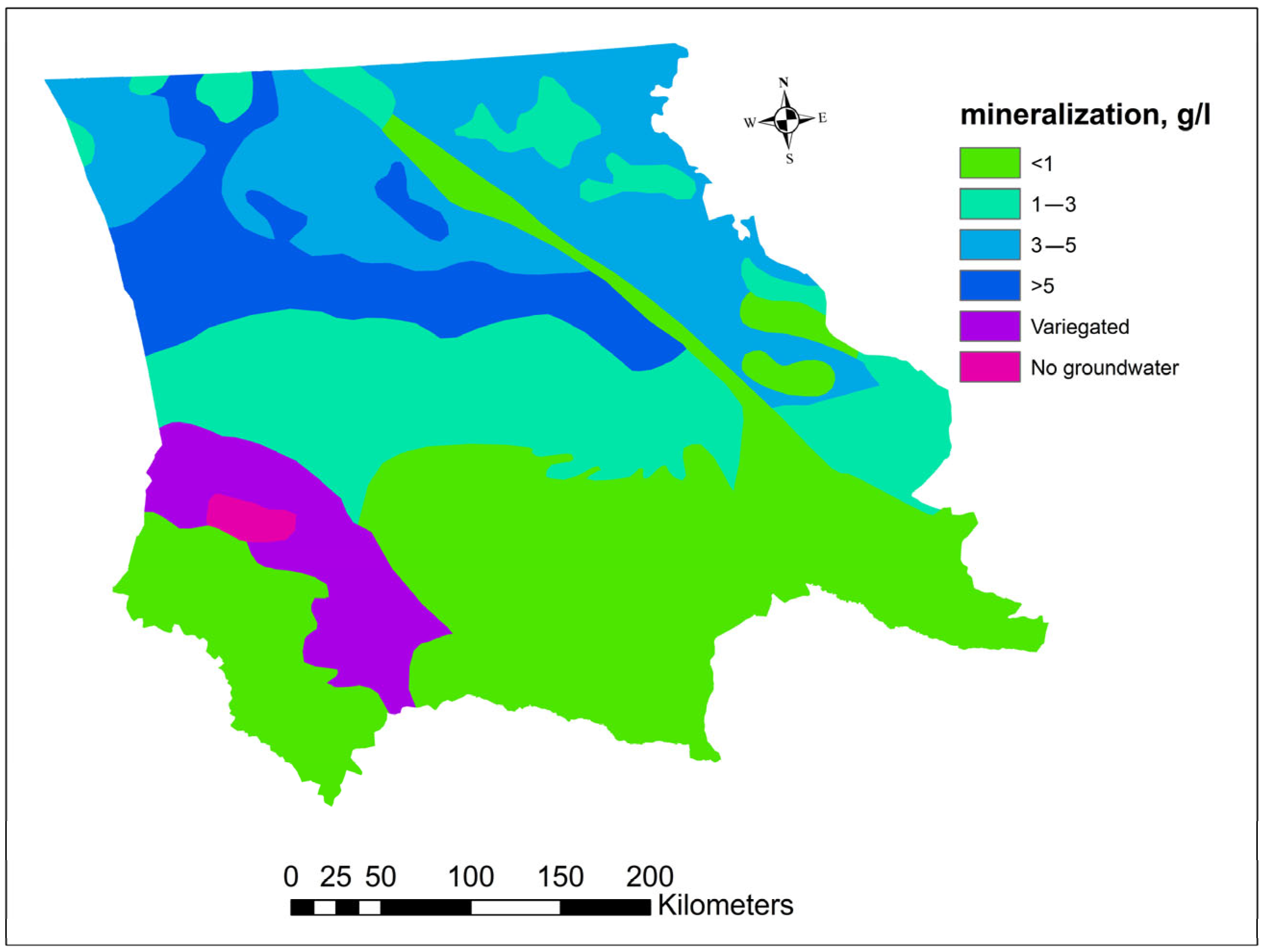
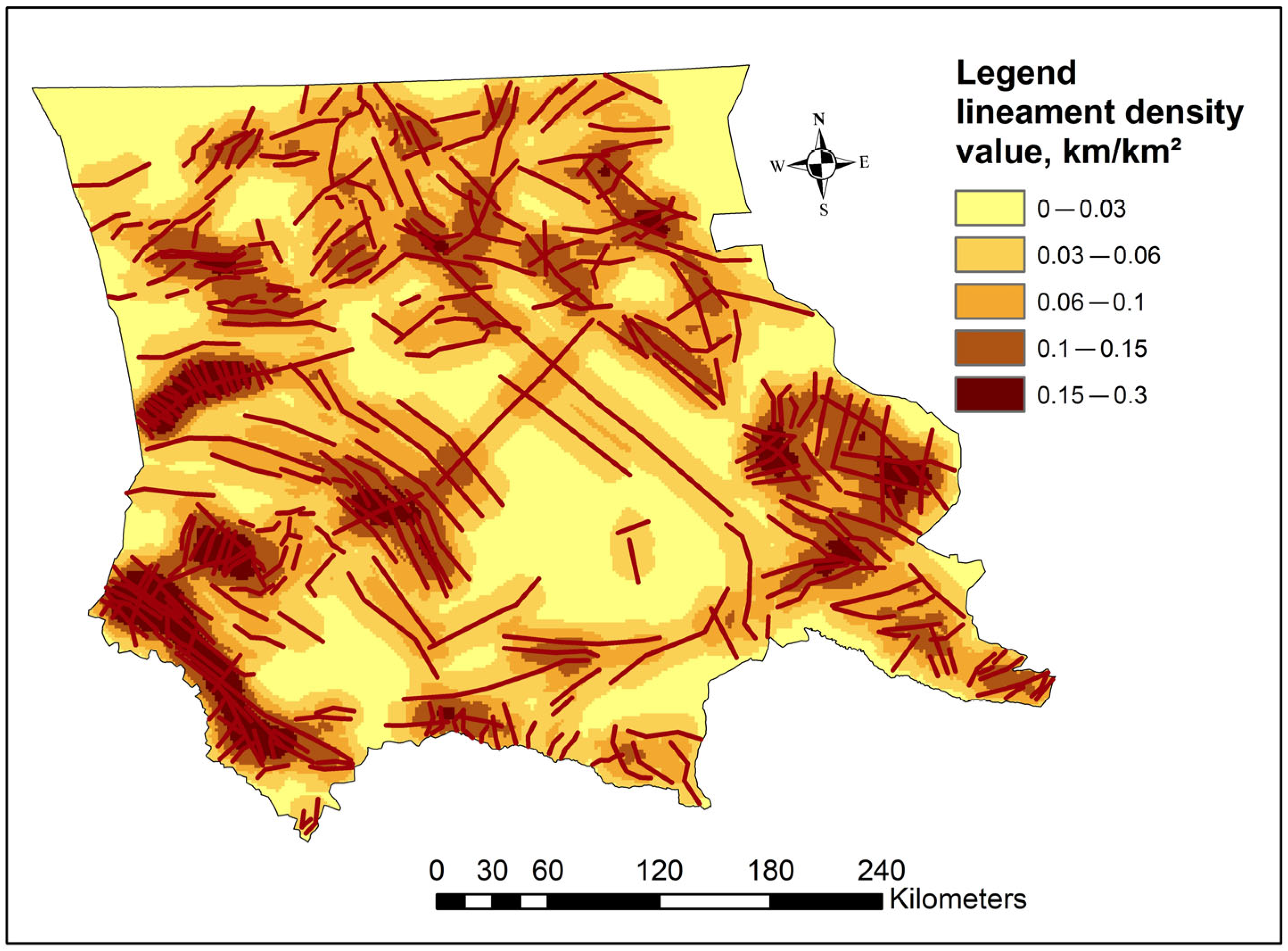
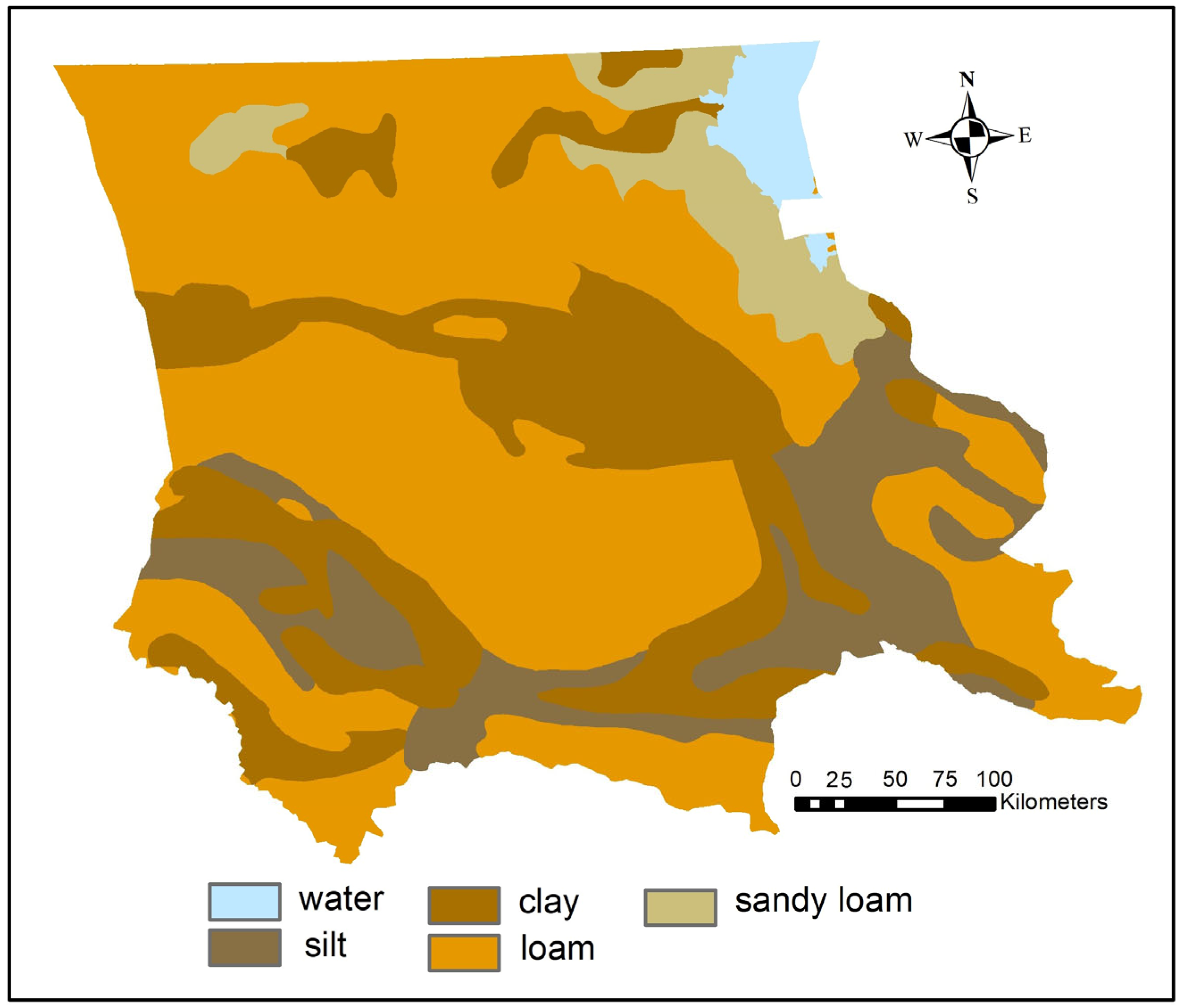


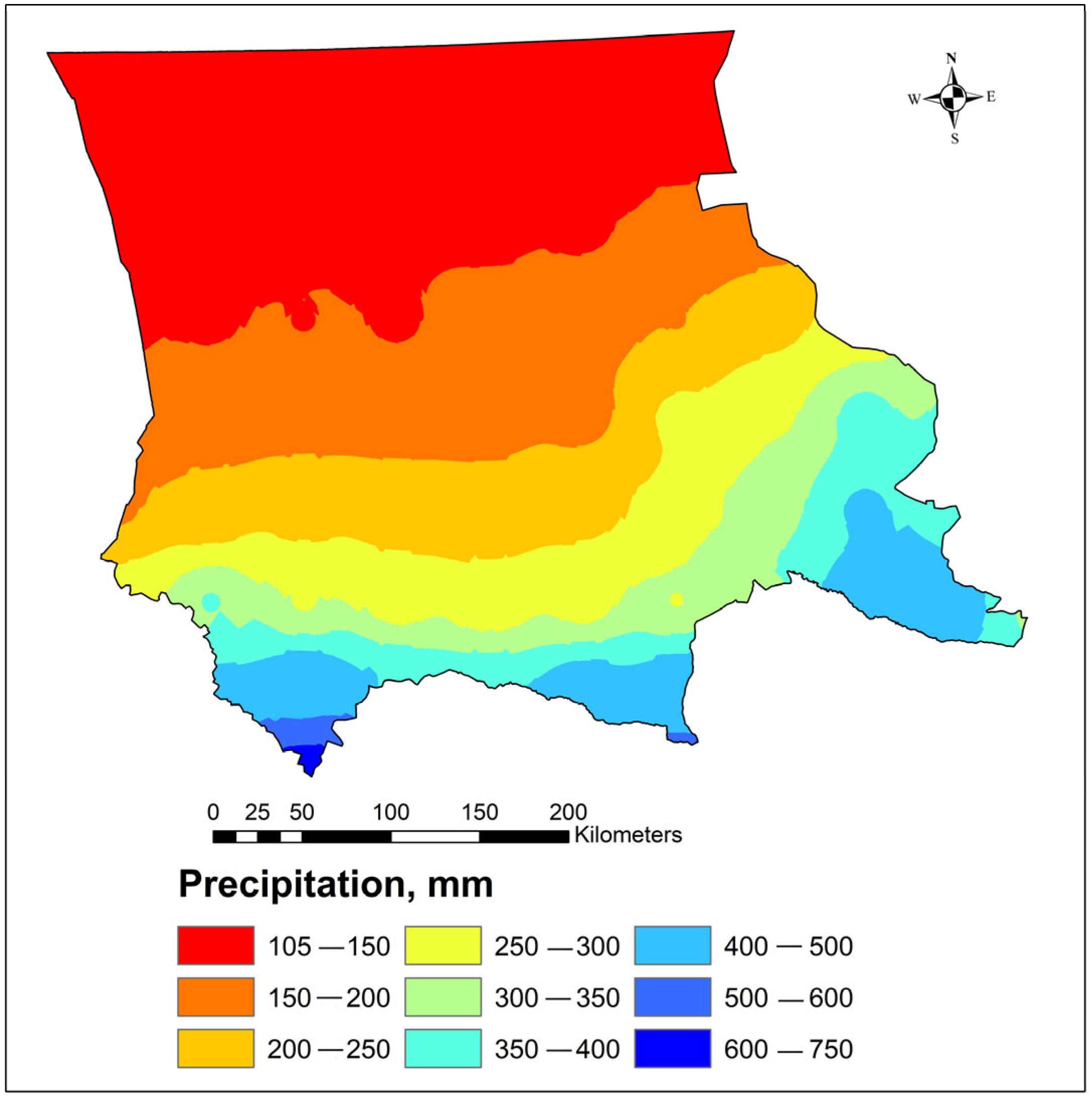


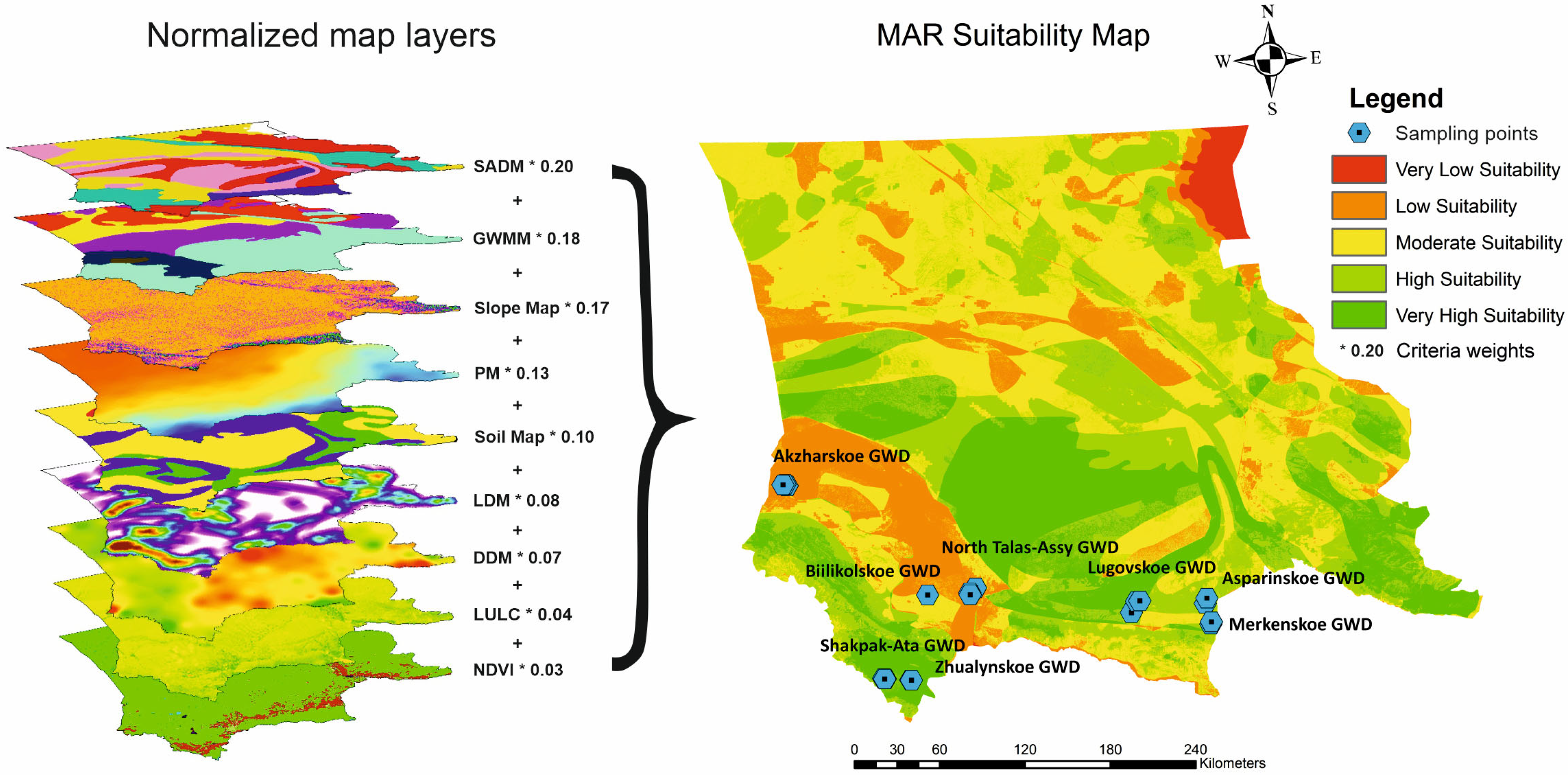



| № | ID | Path | Row | Date | Cloud % |
|---|---|---|---|---|---|
| 1 | LC08_L2SP_150030_20240827_20240831_02_T1 | 150 | 30 | 27 August 2024 | 6.22 |
| 2 | LC09_L2SP_151029_20240826_20240827_02_T1 | 151 | 29 | 26 August 2024 | 0.17 |
| 3 | LC08_L2SP_151030_20240802_20240808_02_T1 | 151 | 30 | 2 August 2024 | 35.05 |
| 4 | LC08_L2SP_152028_20240825_20240831_02_T1 | 152 | 28 | 25 August 2024 | 4.0 |
| 5 | LC08_L2SP_152029_20240825_20240831_02_T1 | 152 | 29 | 25 August 2024 | 1.76 |
| 6 | LC08_L2SP_152030_20240825_20240831_02_T1 | 152 | 30 | 25 August 2024 | 0.25 |
| 7 | LC08_L2SP_153028_20240816_20240822_02_T1 | 153 | 28 | 16 August 2024 | 4.23 |
| 8 | LC08_L2SP_153029_20240816_20240822_02_T1 | 153 | 29 | 16 August 2024 | 5.17 |
| 9 | LC09_L2SP_153030_20240808_20240809_02_T1 | 153 | 30 | 8 August 2024 | 0.19 |
| 10 | LC08_L2SP_154028_20240807_20240814_02_T1 | 154 | 28 | 7 August 2024 | 5.88 |
| 11 | LC08_L2SP_154029_20240823_20240830_02_T1 | 154 | 29 | 23 August 2024 | 12.31 |
| 12 | LC08_L2SP_154030_20240823_20240830_02_T1 | 154 | 30 | 23 August 2024 | 11.78 |
| 13 | LC08_L2SP_155028_20240830_20240906_02_T1 | 155 | 28 | 30 August 2024 | 0.01 |
| SADM | GWMM | PM | Soil Map | Soil Map | LULC | NDVI | LDM | DDM | |
|---|---|---|---|---|---|---|---|---|---|
| SADM | 1.0 | 1.0 | 3.0 | 3.0 | 5.0 | 5.0 | 7.0 | 3.0 | 5.0 |
| GWMM | 1.0 | 1.0 | 3.0 | 3.0 | 5.0 | 5.0 | 7.0 | 3.0 | 5.0 |
| PM | 0.3 | 0.3 | 1.0 | 2.0 | 3.0 | 3.0 | 5.0 | 1.0 | 3.0 |
| Slope Map | 0.3 | 0.3 | 0.5 | 1.0 | 3.0 | 3.0 | 4.0 | 2.0 | 3.0 |
| Soil Map | 0.2 | 0.2 | 0.3 | 0.3 | 1.0 | 2.0 | 2.0 | 2.0 | 1.0 |
| LULC | 0.2 | 0.2 | 0.3 | 0.3 | 0.5 | 1.0 | 2.0 | 2.0 | 1.0 |
| NDVI | 0.1 | 0.1 | 0.2 | 0.3 | 0.5 | 0.5 | 1.0 | 0.5 | 0.5 |
| LDM | 0.3 | 0.3 | 1.0 | 0.5 | 0.5 | 0.5 | 2.0 | 1.0 | 2.0 |
| DDM | 0.2 | 0.2 | 0.3 | 0.3 | 1.0 | 1.0 | 2.0 | 0.5 | 1.0 |
Disclaimer/Publisher’s Note: The statements, opinions and data contained in all publications are solely those of the individual author(s) and contributor(s) and not of MDPI and/or the editor(s). MDPI and/or the editor(s) disclaim responsibility for any injury to people or property resulting from any ideas, methods, instructions or products referred to in the content. |
© 2025 by the authors. Licensee MDPI, Basel, Switzerland. This article is an open access article distributed under the terms and conditions of the Creative Commons Attribution (CC BY) license (https://creativecommons.org/licenses/by/4.0/).
Share and Cite
Onglassynov, Z.; Berndtsson, R.; Rakhimova, V.; Rakhimov, T.; Jabassov, A.; Rakhmetov, I.; Muratova, M.; Tussupova, K. GIS-Based Multi-Criteria Assessment of Managed Aquifer Recharge (MAR) Zones Using the Analytic Hierarchy Process (AHP) Method in Southern Kazakhstan. Water 2025, 17, 2774. https://doi.org/10.3390/w17182774
Onglassynov Z, Berndtsson R, Rakhimova V, Rakhimov T, Jabassov A, Rakhmetov I, Muratova M, Tussupova K. GIS-Based Multi-Criteria Assessment of Managed Aquifer Recharge (MAR) Zones Using the Analytic Hierarchy Process (AHP) Method in Southern Kazakhstan. Water. 2025; 17(18):2774. https://doi.org/10.3390/w17182774
Chicago/Turabian StyleOnglassynov, Zhuldyzbek, Ronny Berndtsson, Valentina Rakhimova, Timur Rakhimov, Abai Jabassov, Issa Rakhmetov, Mira Muratova, and Kamshat Tussupova. 2025. "GIS-Based Multi-Criteria Assessment of Managed Aquifer Recharge (MAR) Zones Using the Analytic Hierarchy Process (AHP) Method in Southern Kazakhstan" Water 17, no. 18: 2774. https://doi.org/10.3390/w17182774
APA StyleOnglassynov, Z., Berndtsson, R., Rakhimova, V., Rakhimov, T., Jabassov, A., Rakhmetov, I., Muratova, M., & Tussupova, K. (2025). GIS-Based Multi-Criteria Assessment of Managed Aquifer Recharge (MAR) Zones Using the Analytic Hierarchy Process (AHP) Method in Southern Kazakhstan. Water, 17(18), 2774. https://doi.org/10.3390/w17182774






